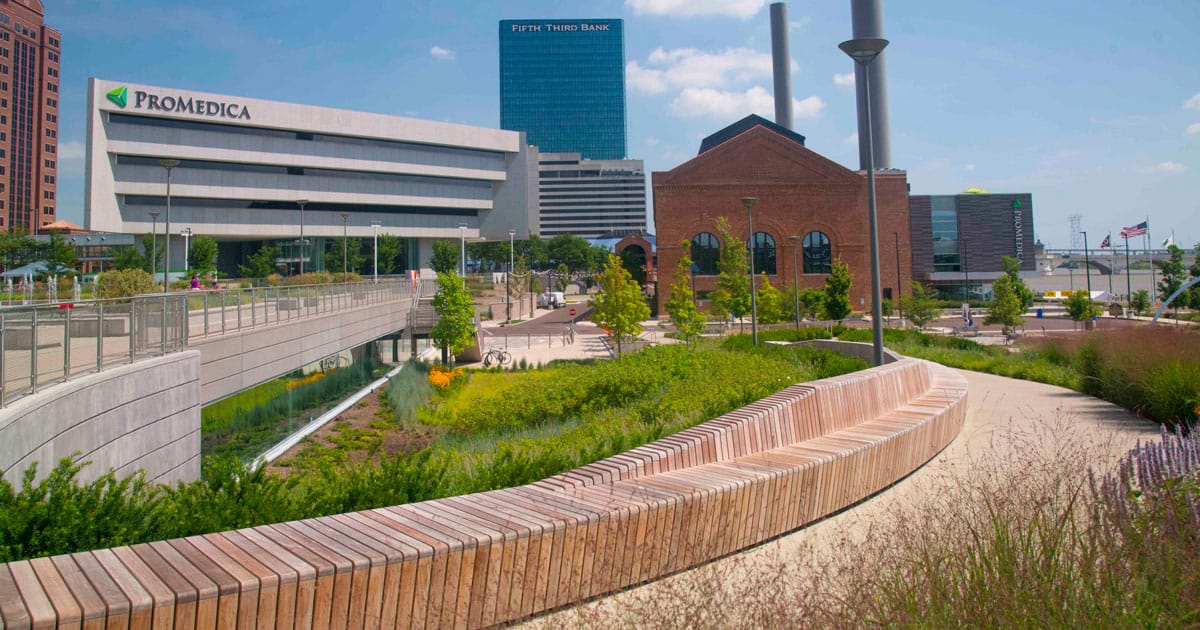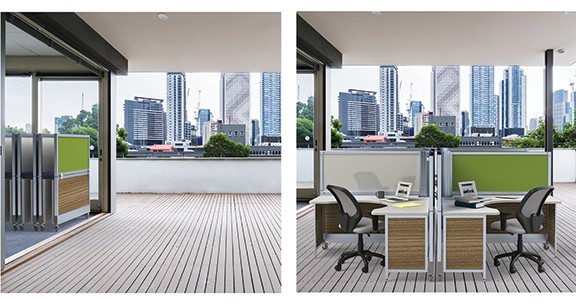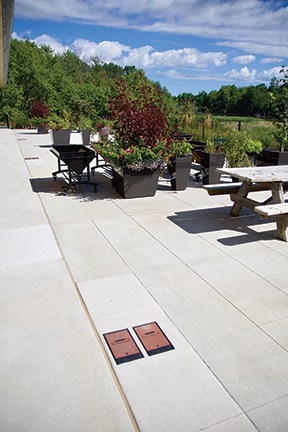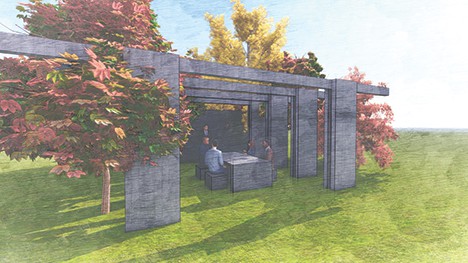Compiled by Facility Executive
From the June 2021 Issue
Facility managers have often sought to utilize outdoor spaces on the properties they manage, providing employees and other users places to take a break from the indoors. The COVID-19 pandemic spurred many to improve the condition of existing outdoor seating areas, or to create these spaces where none previously existed. Whether you have a small space or an expansive site, evaluate the property to see where you might create a space. Here are installations and ideas from several suppliers, and a look at ideas for K-12 schools as well. (Share your outdoor space; send a photo and description to the Editor at acosgrove@groupc.com.)

Outside Seating Makes A Statement
Contributed by Landscape Forms, a provider of integrated solutions of high-design site furniture, LED lighting, structure, and custom environments.
While sites and needs vary, what are the important factors to consider when creating outdoor spaces? As employees return to offices and the public to social and commercial venues, the need for safe and confidence-inspiring natural spaces that facilitate responsible collaboration, connection, and social interaction are more important than ever. These solutions can be comprised of new and reinterpreted products designed to promote physical distancing, while also incorporating key visual cues to make safe outdoor experiences intuitive and welcoming. This can help businesses, institutions, and communities adapt not only to the challenges they face in immediate response to the COVID-19 health crisis, but also to the new expectations for public safety.
Landscape Forms recognizes that some sites may require more customized solutions. To accommodate these special cases, we’ve also identified a large handful of additional products in our line that can be easily customized for use in university, corporate, and healthcare campuses, municipal locations, and other public outdoor spaces.
What is an effective outdoor space you’ve seen? Ohio-based healthcare system ProMedica’s approximately 1,000 employees are now working at a new campus in the heart of downtown Toledo, located at a prime location on the Maumee River and adjacent to city-owned Promenade Park. ProMedica worked with architecture firm HKS to create a headquarters (shown here) that included the restoration of an 1896 Daniel Burnham-designed steam plant, a renovation of the 1981 Brutalist style Junction Building, and construction of a multi-level parking structure. Promenade Park sits between the buildings. Part of the park’s redesign would include a defined element to provide a boundary between the walkway and a detention basin.
MKSK, the landscape architecture and urban planning firm on the project, proposed a bench or series of benches to take advantage of views of the park and Maumee River. The firm had taken notice of a series of custom wood-slated benches that Landscape Forms’ Studio 431 had engineered and manufactured for the Children’s Hospital of Philadelphia. They were drawn to the organic and winding forms of the benches and thought a similar approach would lend itself to the curving, sloped Promenade Park walkway.
“MKSK wanted to give pedestrians a reason to pause along the walkway,” says Studio 431’s Darin Piippo. “They wanted a bench that was sculptural and integrated into the landscape. MKSK could have designed a traditional barrier, but they wanted to do something exceptional.”
Studio 431 engineers and manufacturers collaborated to figure out the intricacies of creating a 100-foot-long continuous bench that spanned a five-percent grade change.
“The sheer scope of the bench presented a challenge,” says Studio 431 project engineer Chad Kendall. “It took a lot of work to engineer and make all the pieces and parts. We knew early on in the process that the construction method was key. We wanted to make the bench self-fixturing so that the pieces would fit together accurately and easily. This design element was instrumental in successfully manufacturing a bench of this scale.”

Inside To Outdoors, Easily
Contributed by Swiftspace, a furniture company with products to create flexible, accessible office spaces that can be adapted without tools or professional installers.
While sites and needs vary, what are the important factors to consider for outdoor spaces? As employees are returning to the workplace, the focus is about how organizations can create an overall healthier work environment. This has resulted in landlords, facility managers, and space planners building in access to outdoor space. Over the last several months, there has been a noticeable change in language when people who are planning workplaces discuss the use of this “Outdoor Space.”
It is no longer about designing a social gathering space that folks can escape to for that shot of Vitamin D from the sun. It is about the creation of the same type of spaces to work and interact on both sides of the window (shown above).
As the amount of square footage available outside is limited in comparison to inside, the use of flexible and mobile furniture is critical as employees want to duplicate the ways they work on both sides of the windows.
What is an effective outdoor space you’ve seen? Mobile workstations with integrated walls allow users to quickly move from small collaborative hubs to private work areas. Add in mobile meeting booths for two people, which can also be combined together for meeting space for larger groups—and you can provide multiple ways to work in the same space with the same furniture.
And finally, don’t forget about the sun in outside planning. Be sure to provide opportunities to be able to roll the furniture under cover to provide workspace that is protected from the sun. Another advantage of mobile furniture: it can easily be moved under cover or inside during inclement weather.

Powering The Outdoors
Contributed by Legrand, a leading provider of innovative electrical solutions.
While sites and needs vary, what are the important factors to consider when creating outdoor spaces? Today’s workplaces are expanding beyond the four walls of an office or classroom. As technology evolves, employees and students alike are looking for new and alternative workspaces to inspire creativity and increase productivity. Many want to take their work to outdoor spaces, but it’s challenging for facility managers and property owners to bring technology outside. When considering installing outdoor power and data solutions, there are a handful of factors to consider.
Before taking on a project, it is important to look at these factors: the scale of the project, budget, timing, and labor. Some projects require more work on the front end to prepare the space, like trenching, which is more labor-intensive and sometimes not an option for outdoor space. Other solutions can be installed more easily and as a less permanent solution. Once you have taken a look at the project’s goal, it’s important to think about who will be using the outdoor power solutions.
For facility or maintenance teams, look for permanent solutions like Legrand’s ground box or high amperage power pedestal. If there are events or larger gatherings, you’ll want to add in power access throughout the space that can handle higher amperage and/or other connections like A/V. These products blend in with landscaping, while giving a facility team member enough power to manage more heavy-duty applications. The ground box can be installed with turf on it, which can theoretically make it “disappear.” The power pedestal is a good option instead of stubbing up conduit, which is unattractive and can be dangerous. It’s also important to consider bringing USB charging solutions into your outdoor space as well to accommodate employee or student needs. These types of power access are better for charging phones or even laptops.
What is an effective outdoor space you’ve seen? Legrand worked on the transformation of the Frederik Meijer Gardens & Sculpture Park in Grand Rapids, MI (shown below) to turn it from a small horticultural society into a world-renowned institution. Since opening in 1995, the number of visitors and members has skyrocketed, and the exhibits and programs have expanded as a result. They now have over 28,000 member families and about 40,000 visiting students from all over the world each year. This project is a great example of creating a sustainable outdoor experience not restricted by weather and access.
In 2017, Meijer Gardens announced a multi-phase, $115 million renovation project, aimed to increase the annual guest attendance of 1.2 to 1.5 million. To plan for the increase, Meijer Gardens needed to add new features, update existing features, and incorporate power throughout the facility. They turned to Legrand and chose to install the Wiremold® Ground Box throughout the gardens. The low-profile ground box mounts flush with any outdoor ground surface allowing the facility to incorporate different types of power throughout the grounds. In addition, the devices can withstand harsh weather conditions and can support up to a 5,000-pound load. This allowed Meijer Gardens to incorporate power for a variety of events, programs and classroom activities without compromising the beauty of the gardens or detracting from the artwork.

Conference Rooms On The Grounds
Michael Pallone, president of Wollaston Development, a Greater Boston-based site development and property design company, reveals factors to consider when planning a safe, effective space outside the office.
While sites and needs vary, what are the important factors to consider? With millions of Americans receiving COVID-19 vaccinations and U.S. cases dropping daily, businesses are finally bringing their employees back to the office. To ensure employee safety during the pandemic, workplaces have drastically restructured the form and layout of their indoor and outdoor spaces, leading to design trends which, projections say, are here to stay for good.
Businesses, particularly those located in suburban office parks, are seeking to take advantage of the property surrounding their offices by converting existing space into permanent outdoor workspaces. Whether you are designing an outdoor conference room for group meetings or a space that allows for individual work, the spaces need to maximize employee productivity by providing all the resources found inside the office in a safe, outdoor environment.
With a conference table built for easy cleaning and weathering the elements, a video conference screen that lowers into the patio floor when not in use, lighting fixtures, retractable awnings, internet access, and electrical outlets and phone lines, a well-designed open-air conference room (shown above) features the amenities of a traditional conference room. Also, with the appropriate heating elements included, all the outdoor designs can be utilized from early spring to late fall in areas of the country that experience harsh, cold winters.
Pergolas, with benches and granite tables, can provide excellent shade for individual workspaces. Thoughtfully designed and scattered across the property, these pergolas are not only functional, but can aesthetically enhance the grounds. It is essential that each outdoor space seamlessly integrates into the property while meeting the specific needs of the workplace.
Even the breakroom is no longer relegated to the building’s interior. Sturdy, fully applianced outdoor kitchens featuring heating elements, such as fire pits, provide a great place for employees to safely gather and eat outside. It also provides a terrific space to host company functions. Companies need to get creative to navigate the post-pandemic world and adapt to the permanent changes to the way people will be working. These concepts are just a few of the ways that they are doing it.

Learning In The Great Outdoors
Lauren McKenna, MLA, program manager at Green Schoolyards America, a national organization working to expand and strengthen the green schoolyard movement, writes:
While sites and needs vary, for schools what are the important factors to consider? Green Schoolyards America works with school districts and public agencies to transform asphalt-covered school grounds into park-like green spaces (shown below) that improve children’s well-being, learning, and play while contributing to the ecological health and resilience of their cities.
The National COVID-19 Outdoor Learning Initiative was founded in June 2020 to support schools and districts around the country in their efforts to reopen safely and equitably during the pandemic, using outdoor spaces as strategic, cost-effective solutions to increase physical distancing capacity on-site and provide access to abundant fresh air. The Initiative seeks to equitably improve learning, mental and physical health, and happiness for children and adults using an affordable, time-tested outdoor approach to keeping schools open during a pandemic and beyond. Other founders of the Initiative are The Lawrence Hall of Science, San Mateo County Office of Education, and Ten Strands.
School facility planners are an integral part of implementing successful outdoor learning efforts, whether they are temporary or permanent. It is important to begin the planning process by engaging the school community in a site walk to assess which areas of the campus have potential for outdoor classes and programs.
A simple outdoor classroom can be created by moving items the school already owns—such as mounted whiteboards, seats, and desks—outdoors into shaded locations. Schools can expand capacity by adding inexpensive seating like tree stumps. To improve acoustics and reduce ambient noise, space class cohorts apart and consider noise buffers such as fabric panels, straw bales, or potted shrubs. Facility planners can assist school teams by highlighting areas that need to remain unobstructed, such as fire lanes and building and restroom entrances.
Physical comfort is centrally important for successful outdoor programs. Design outdoor spaces with comfortable seating and workspaces for teachers and students. Nestle outdoor classrooms into existing shade or shelter from mature trees, covered walkways, or building overhangs. If temporary shade or rain protection is needed, consider adding tents, shade sails, or carports as local building codes allow.
Permanent open-sided pavilions can be a wise investment since they offer protection from rain and sun. Remove asphalt and hot rubber surfaces, and plant deciduous trees in student-accessible locations on-site to reduce ambient temperatures.
We encourage facility planners to consider both buildings and grounds equally when creating Facility Master Plans. Facility planners can be on-the-ground advocates for living schoolyards that provide access to nature and health and learning benefits for students and teachers. Facility planners are our heroes—you have the power to enrich children’s lives by creating nature-rich infrastructure investments that prioritize ecological and human health.
Share your outdoor space project or ideas with Facility Executive editors; send a photo and description to us at acosgrove@groupc.com. You can also share your thoughts about this article in the Comments section below.


















![[VIDEO] Collect Asset Data at the Speed of Walking a Building](https://facilityexecutive.com/wp-content/uploads/2024/02/maxresdefault-324x160.jpg)